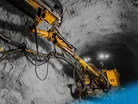Industrial IoT Behind Data-Driven Mining Tech Innovation

Forward-looking mining organisations are increasingly turning to IoT networks to transform operations into fully connected networks. Sensor data and Radio Frequency Identification (RFID) from machinery and equipment can deliver real-time asset tracking, monitoring, and alerts that help streamline tasks and minimise disruption.
A subset of the IoT – which consumer-facing uses such as wearable devices and smart home technology – is the Industrial IoT (IIoT). This consists of internet-connected machinery and advanced analytics platforms that process the data generated by IoT devices, which range from tiny environmental sensors to complex industrial robots.
Although the world ‘industrial’ conjures images of heavy machinery, IIoT technology is revolutionising a range of industries. As wellas mining, these include agriculture, healthcare, financial services retail and even advertising.
For businesses such as mining companies, which produce, process and transport physical commodities – IIoT tech can offer significant efficiencies, helping them reimagine operational modus operandi.
The mining industry's embracing of IIoT tech reflects a broader trend of digital transformation. As companies continue to invest in these technologies, the benefits are likely to extend beyond equipment maintenance.
IoT data can help cut environmental impact
IIoT data can provide insights into operational efficiency, energy consumption and – so crucial in an industry such as mining – environmental impact. This information helps mining companies optimise their processes and improve their sustainability performance.
The benefits of IoT technology are substantial and include increased visibility, more collaboration, better customer service and real-time tracking of goods.
Yet although IIoT has enormous potential to help, mining companies – as with any industry using the technology – must be assiduous about how data is harvested, and then used
Leading US-based international mining company Freeport-McMoRan is one major mining operation using IIoT technology, which underpins a predictive maintenance system that is part of its Haul Truck Management System (HTMS), which monitors the performance of haul trucks in real-time.
It uses GPS tracking and onboard sensors to collect data on truck speed, payload, fuel consumption, and other parameters. This information is used to optimise fleet performance and schedule maintenance.
The company reports that HTMS has helped increase truck availability by 5% and reduce maintenance costs by 10%. The system has also improved fuel efficiency and reduced tyre wear.
“We look forward to partnering with Caterpillar to become the first US copper mine to implement a fully autonomous haulage system and are excited about the numerous benefits it will bring to our Bagdad operation and employees,” said Kathleen Quirk, President, Freeport-McMoRan.
SAP helps firms manage colossal IIoT data sets
Andy Hancock is Global VP Centre of Excellence, SAP Digital Supply Chain. The Centre of Excellence is like a global SWAT team of industry experts, serving SAP colleagues in the field, with knowledge transfer. Hancock points out that IIoT networks generate mountains of data and warns that powerful 5G technology – with its huge data capabilities – can “make people lazy, and so they end up throwing tons of information around just because they can”.
He adds: “The trouble is that when you scale-up this approach to enterprise level you soon end up with 50 million data points that flood the network, making it inefficient.
"The danger is that businesses who fall into this trap then end up chucking more technology at the problem, where really what they should be doing is coming back to fundamentals.
"The secret to working with big data, like that generated by IIoT networks, is to always be looking out for exceptions."
He adds: “Think of a temperature gauge on a piece of equipment that is feeding back data. As long as everything is running okay, the equipment will always be roughly the same temperature.
“You don’t need to keep feeding back data about that piece of equipment. The only data you want to capture is if something changes – for example, if the thermostat fails.
“IIoT devices are creating data 24/7, so the idea is you discard most of it and look for the exception - the piece of data that shows a machine is overheating, or out of calibration. With data, less is usually more.”
__________
Mining Digital is a BizClik brand




